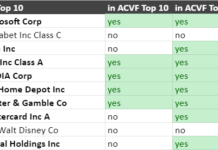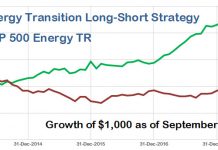UPDATE 3/4/2011: An up-to-date article on selecting green mutual funds and ETFs can be found here.
Most investors looking to get into clean energy think first of mutual funds. Here are the options, and how to choose.
We track seven mutual funds with a focus on green energy and climate change at AltEnergyStocks.com, since the American Trust Alternatives Fund closed early this year. I split them into two categories: the funds with a primary focus on clean energy, and those with a primary focus on the environment.
The clean energy funds are: the Firsthand Alternative Energy Fund (ALTEX), the Guinness Atkinson Alternative Energy Fund (GAAEX), and the Calvert Global Alternative Energy Fund (CGAEX/CGACX). The environmental funds are the Allianz Global Eco Trends Fund (AECOX), the DWS Climate Change Fund (WRMSX), the New Alternatives FD Inc (NALFX), and the Winslow Green Growth Fund (WGGFX).
Since carbon emissions from energy use are the major driver of climate change, there is a large overlap between the strategies of the environmental funds and energy funds, but there are still meaningful differences. First, while energy and water are closely linked, the clean energy funds seldom have any investments in water infrastructure. In contrast, the environmental funds not only have significant investments in water, they also invest in environmental clean-up and waste management to a much greater extent than the energy funds.
Fund Holdings
Below is a breakdown of these mutual funds’ holdings, based on the mutual funds’ own classifications or my classifications of the stocks in their portfolios, depending on what information I was able to find using Morningstar and the funds’ sponsor web pages.
The sector breakdown shown here is only approximate for AECOX and WRMSX, because I was only able to find the top ten holdings of each of these funds, and the industry break-downs published by these funds do not differentiate between types of alternative energy.
After the significant allocations to water infrastructure and environmental cleanup among the environmental funds, the most noticeable difference between these two groups of funds is the allocation to solar energy. This also makes sense given the two groups’ focus. There is little argument that solar has great potential to provide a large proportion of the electricity that society needs. However, the current potential for solar power to significantly reduce carbon emissions from energy production are limited by the current high cost of the technology. That will change as the cost comes down, but until it does, investors interested in reducing harmful greenhouse gasses will be much more effective if they place their investments in efficiency, wind, or forestry.
In short the choice between the environmental group of funds and the clean energy group should rest on your goals as an investor. Investors who are most interested in preserving the environment for future generations will prefer funds from the environmental group, while investors looking to profit from the transition to clean energy will prefer funds in the clean energy group.
Costs
Investors should also consider cost when looking at any investment. Below is a chart of the costs of investing in each of these funds, with the data from Morningstar. 
An investor pays the front-end load just to make an investment in fund that have them. Larger investments may reduce the percentage front-end load from those shown. The expense ratio is the percentage of the investment which goes to pay the mutual fund’s expenses every year. Institutional expense ratio is the expense ratio paid by 401(k) plans and other institutional investors which the fund grants a discount in return for a large amount of business. The Calvert fund offers both "C" shares (CGACX), with no front-end load but a higher annual expense ratio, and "A" shares (CGAEX), with a front-end load but lower annual expenses.
If you can invest in any of these funds through a 401(k) or other sponsored retirement plan (as opposed to an IRA), you will generally be paying the institutional expense ratio. As an individual, you will generally have to pay both the front-end-load (if any), and the ongoing annual expense ratio.
In general, these expenses are all very high by the standards of mutual funds. Because of these high costs, I generally recommend investing in a green energy Exchange Traded Fund(ETF), rather than a green energy mutual fund. I’ve shown the approximate cost of investing in a green energy ETF on the same chart for comparison. I will publish an article comparing the green energy ETFs here in the next few days. (The link will be broken until then.)
The Best Green Mutual Funds
If you still prefer a green mutual fund despite the cost, the best choice among the environmental funds is clearly the Winslow Green Growth Fund (WGGFX). The lack of front-end load for this fund means that an investor in the New Alternatives fund (the only environmental fund with a lower annual expense ratio) would have to wait 15 years before the lower annual expenses were enough to pay back the high up-front cost.
Among the clean energy funds, I think the Guinness Atkinson fund (GAAEX) is the least unappealing. While its expense ratio is still a high 1.69%, it has no front-end load, and even this high annual expense ratio is lower than the annual expenses of the other clean energy focused funds. I also prefer the Guinness Atkinson fund to the First Hand fund because of the more diverse portfol
io. Solar is the most volatile of green energy sectors, and ALTEX’s large allocation to solar means that an investor in the fund gains fewer benefits of diversification than an investor in GAAEX.
However, most investors who have the option will be better off in a green energy ETF than a green energy mutual fund.
DISCLOSURE: GAAEX is an advertiser on AltEnergyStocks.com.
DISCLAIMER: The information and trades provided here are for informational purposes only and are not a solicitation to buy or sell any of these securities. Investing involves substantial risk and you should evaluate your own risk levels before you make any investment. Past results are not an indication of future performance. Please take the time to read the full disclaimer here.









Nice article. Some of those expenses are disgusting!